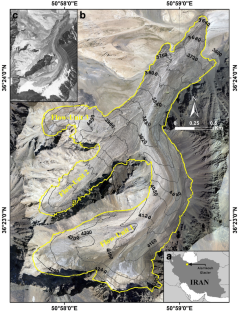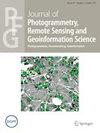利用大地遥感卫星表面温度产品研究伊朗被碎屑覆盖的 Alamkouh 冰川表面温度的十年变化(1985-2020 年
摘要
本研究旨在评估位于伊朗的碎屑覆盖的阿拉姆库赫冰川(冰川总面积的 88% 以上被碎屑覆盖)在 1985 年至 2020 年期间的冰川表面温度(GST)的时间变化。分析采用了空间分辨率为 30 米的大地遥感卫星表面温度产品。该研究有三个主要目标:(1)对冰川表面温度变化进行时空分析;(2)评估冰川表面温度与冰川变量(如冰厚变化和反照率)之间的相关性;(3)利用全球陆地数据同化系统数据集确定影响冰川表面温度的因素,包括气温、云层、降水和降雪。利用 Mann-Kendall 趋势检验和森斜率估算器分析了空间变化,结果显示所有多时参数在统计上都呈现显著的正或负趋势。空间变化分析表明,从 1985 年到 2020 年,全球平均温升在 0 到 +0.2 °C/a 之间。整个冰川的年平均 GST 升幅为 0.086 °C/a,即在 36 年内上升了 3 °C。与低海拔地区相比,高海拔地区的 GST 增幅更大,但整个冰川表面的明显模式仍然难以捉摸。为了补充空间 GST 分析,我们将研究期间分为 1985-1990、1990-2000、2000-2010 和 2010-2020 四个时期,并分别计算了消融月份的平均 GST。结果表明,1985-1990 年至 1990-2000 年期间平均 GST 保持稳定,1990-2000 年至 2000-2010 年期间 GST 显著增加,增幅最大,为 2.3 ℃/十年。36 年的时间变化分析表明,在积雪月和消融月期间,瓦砾覆盖地区的升温最为显著(0.139 °C/a),而无瓦砾地区的升温较小(0.097 °C/a)。研究采用归一化差异积雪指数来识别无瓦砾地区,并评估其对全球变暖潜势的影响。首先,研究结果表明,全球降雪量与无碎片地形的范围之间存在稳健的反比关系。其次,分析表明,自 1985 年以来,无碎片地形以每月-0.035%的速度显著减少,在 36 年的时间里减少了 15.12%,其中包括积雪期和消融期。此外,反照率分析结果表明,反照率与平均全球降水量之间存在明显的负相关关系,R2 为 0.57。对反照率变化的研究表明,整个冰川地形的反照率每年大幅下降约-0.08/a,而低海拔地区的反照率在 36 年间保持稳定,高海拔无碎屑地区发生了显著变化。与此相反,通过全面研究发现,冰川冰层减薄率与全球降水量变化之间无法确定稳固的联系。在气候变量中,气温显著变暖,从 1985 年到 2020 年以 0.016 °C/a 的速度增长,而其他变量则保持稳定。了解这些对冰川表面温度的多方面影响对于适应冰川地区持续的气候变化至关重要。要厘清气候参数之间错综复杂的相互作用及其对冰川动力学的累积影响,还需要进一步的研究。

This study aimed to assess the temporal changes in glacier surface temperature (GST) for the debris-covered Alamkouh glacier (over 88% of the total glacier area is debris covered), located in Iran, over the period from 1985 to 2020. The analysis employed the Landsat surface temperature product at a spatial resolution of 30 m. The research pursued three primary objectives: (1) a spatiotemporal analysis of GST changes, (2) an evaluation of correlations between GST and glacier variables such as ice-thickness change and albedo, and (3) the identification of factors influencing GST, including air temperature, cloud cover, precipitation, and snowfall, utilizing the Global Land Data Assimilation System dataset. Spatial changes were analyzed using the Mann–Kendall trend test and Sen’s slope estimator, revealing statistically significant positive or negative trends in all multitemporal parameters. The spatial change analysis showed that GST increased between 0 and +0.2 °C/a from 1985 to 2020. The mean annual GST increase for the entire glacier is 0.086 °C/a, signifying a 3 °C rise over 36 years. High-altitude regions exhibit more substantial GST increases than lower-altitude areas do, although a discernible pattern across the glacier’s surface remains elusive. To complement the spatial GST analysis, we divided the study period into four periods, 1985–1990, 1990–2000, 2000–2010, and 2010–2020, and mean GST was calculated separately for ablation months. Results indicate stability in mean GST from 1985–1990 to 1990–2000, followed by a significant increase of 2.3 °C/decade from 1990–2000 to 2000–2010, representing the largest increase observed. Temporal change analysis over 36 years reveals that the most significant warming occurs in debris-covered areas (0.139 °C/a), with less warming observed in debris-free regions (0.097 °C/a) during both accumulation and ablation months. The study employed the normalized difference snow index to identify debris-free areas and assess their potential impact on GST. First, the results establish a robust inverse relationship between GST and the extent of debris-free terrain. Second, the analysis demonstrates a significant reduction in debris-free terrain at a rate of −0.035% per month since 1985, culminating in a 15.12% decline over 36 years, encompassing both accumulation and ablation periods. Additionally, outcomes from the albedo analysis reveal a robust negative correlation between albedo and mean GST, with an R2 of 0.57. The examination of albedo alterations shows a substantial annual decrease of approximately −0.08/a across the entirety of the glacier terrain, while albedo remains stable in low-elevation areas over the 36-year period, with significant changes occurring in high-elevation debris-free regions. In contrast, a comprehensive examination reveals that a robust association between the glacier ice-thinning rate and GST change cannot be ascertained. Among climate variables, air temperature exhibits significant warming, increasing at a rate of 0.016 °C/a from 1985 to 2020, while other variables remain stable. Understanding these multifaceted influences on glacier surface temperature is vital for adapting to ongoing climate changes in glacial regions. Further research is needed to disentangle intricate interactions among climate parameters and their cumulative effects on glacier dynamics.

 求助内容:
求助内容: 应助结果提醒方式:
应助结果提醒方式:


